Did you know that Korean radish is not only a delicious ingredient but also packed with health benefits? This versatile vegetable adds a unique twist to traditional dishes while providing a nutritious punch. Whether you’re a fan of Korean cuisine or looking to try something new, exploring Korean radish recipes is a great way to incorporate a healthy twist into your meals.
Key Takeaways:
- Discover the versatile and delicious world of Korean radish recipes.
- Blend traditional flavors with a healthy twist using Korean radish.
- Incorporate Korean radish into your diet for its low calorie and high fiber content.
- Explore the health benefits of Korean radish, including vitamin C and antioxidants.
- Choose the right cooking methods and ingredients to enhance the natural flavors of Korean radish.
Easy and Flavorful Radish Kimchi Recipe
Radish Kimchi is a fast, flavorful, and exciting condiment that you can easily make at home. This authentic recipe uses Korean red pepper flakes, known as gochugaru, to give the kimchi its characteristic bright red hue and spicy kick. With just a few simple steps, you can create your own batch of delicious radish kimchi.
To make radish kimchi, you’ll need:
- 2 large radishes, shredded
- 3 tablespoons gochugaru (Korean red pepper flakes)
- 1 tablespoon fish sauce
- 1 tablespoon minced garlic
- 1 teaspoon grated ginger
- 1 tablespoon sugar
- 1 tablespoon salt
- 2 green onions, sliced
To prepare the radish kimchi:
- In a large bowl, combine the shredded radish and salt. Mix well and let it sit for about 10 minutes to draw out excess moisture.
- In the meantime, mix the gochugaru, fish sauce, minced garlic, grated ginger, and sugar in a separate bowl to create a flavorful paste.
- Rinse the radish under cold water to remove the salt, then squeeze out any excess liquid.
- Add the radish to the paste and mix until well coated.
- Finally, stir in the sliced green onions.
Transfer the radish kimchi into a clean glass jar, pressing it down firmly to remove any air bubbles. Leave about an inch of headspace to allow for fermentation. Seal the jar and leave it at room temperature for 1-2 days to allow the flavors to develop and the kimchi to ferment.
Once the kimchi has reached your desired level of fermentation, refrigerate it to slow down the fermentation process and enhance the flavors. It will continue to ferment slowly in the refrigerator, becoming more flavorful over time.
Radish kimchi can be enjoyed on its own as a side dish, added to soups and stews for extra flavor, or used as a topping for rice bowls and wraps. Its tangy, spicy, and slightly sour taste is sure to add a delicious twist to any meal.
Try this easy and flavorful radish kimchi recipe today and elevate your Korean cuisine experience!
Korean Radish Stir Fry Recipe
Looking for a quick and flavorful dish to satisfy your taste buds? Try this Korean Radish Stir Fry recipe that combines the natural sweetness and crunchiness of radish with savory ingredients like garlic, ginger, and soy sauce. It’s a perfect side dish or main course that you can whip up in no time.
Here’s what you’ll need:
- 1 medium Korean radish, julienned
- 2 cloves of garlic, minced
- 1-inch piece of fresh ginger, grated
- 2 tablespoons soy sauce
- 1 tablespoon sesame oil
- 1 tablespoon vegetable oil
- Salt and pepper to taste
Here’s how to make it:
- In a large skillet, heat the vegetable oil over medium-high heat.
- Add the minced garlic and grated ginger to the skillet and sauté for about a minute until fragrant.
- Add the julienned Korean radish to the skillet and stir fry for about 5 minutes until slightly softened.
- In a small bowl, whisk together the soy sauce, sesame oil, salt, and pepper.
- Pour the sauce mixture over the stir fry and toss well to coat the radish evenly.
- Continue stir frying for another 3-4 minutes until the radish is tender-crisp.
- Remove from heat and serve hot as a side dish or top with your choice of protein for a satisfying main course.
Enjoy the delightful combination of flavors in this Korean Radish Stir Fry. The natural sweetness of radish, enhanced by the aromatic garlic, ginger, and savory soy sauce, is simply irresistible. It’s a perfect accompaniment to steamed rice or as a complement to your favorite Korean dishes.
Refreshing Korean Radish Salad Recipe
Looking for a light and refreshing salad to complement your meal? Try this easy Korean Radish Salad recipe. Made with thinly sliced radish and a zesty garlic vinaigrette dressing, this salad is perfect for summer or any time you crave a crunchy and tangy dish.
What makes this salad so irresistible is the combination of flavors and textures. The radish provides a crisp and refreshing bite, while the garlic vinaigrette adds a tangy and savory kick. This salad pairs well with a variety of main dishes or can be enjoyed on its own.
Here’s a quick and easy recipe to make your own Korean Radish Salad:
- Start by peeling the radish and cutting it into thin slices. You can use a mandoline or a sharp knife for this.
- In a small bowl, mix together minced garlic, rice vinegar, soy sauce, honey, and sesame oil to create the garlic vinaigrette dressing.
- Place the radish slices in a large bowl and pour the dressing over them. Toss gently to ensure that every slice is coated with the flavorful dressing.
- Let the salad marinate in the refrigerator for at least 30 minutes to allow the flavors to meld together.
- Serve the Korean Radish Salad chilled and garnish with sesame seeds for an extra touch of flavor and presentation.
This salad is not only delicious but also visually appealing, with the vibrant white color of the radish contrasting beautifully with the dark sesame seeds. The crunchiness of the radish combined with the tangy garlic vinaigrette creates a delightful texture and taste experience that will leave you craving for more.
Whether you’re enjoying a Korean-inspired meal or simply looking for a refreshing side dish, this Korean Radish Salad is a perfect choice. Its simplicity and versatility make it an excellent addition to any menu.
Nutritious Korean Radish Soup Recipe
If you’re looking for a nourishing and comforting dish, look no further than Korean Radish Soup. Not only is this soup packed with flavor, but it’s also rich in vitamins and minerals, making it a healthy choice for a satisfying meal.
To make this delicious Korean Radish Soup, you’ll need:
- 2 pounds of Korean radish, peeled and cubed
- 1 pound of beef (such as brisket or short ribs), thinly sliced
- 1 onion, thinly sliced
- 4 cloves of garlic, minced
- 1 tablespoon of soy sauce
- 1 tablespoon of sesame oil
- Salt and pepper to taste
- 6 cups of water or beef broth
To prepare the Korean Radish Soup:
- In a large pot, heat the sesame oil over medium heat. Add the beef and cook until browned.
- Add the onion and garlic to the pot and sauté until the onion becomes translucent.
- Add the Korean radish, soy sauce, salt, and pepper to the pot. Stir well to combine.
- Pour in the water or beef broth and bring the soup to a boil.
- Reduce the heat to low and simmer the soup for about 30 minutes, or until the radish is tender.
- Taste the soup and adjust the seasoning if needed.
- Serve the Korean Radish Soup hot and enjoy!
This hearty soup is perfect for cold days or whenever you’re in need of a comforting meal. The combination of tender Korean radish, flavorful beef, and aromatic seasonings will warm you up from the inside out. And the best part? It’s incredibly easy to make!
Here’s a visual representation of the Korean Radish Soup Recipe:
Health Benefits of Korean Radish Soup
In addition to being delicious, Korean Radish Soup offers several health benefits. The radish itself is low in calories and high in fiber, which can aid in weight management and promote digestion. It’s also a good source of vitamin C, potassium, and antioxidants, which can support immune function and protect against oxidative stress.
| Health Benefits of Korean Radish Soup | Explanation |
|---|---|
| Rich in Vitamin C | Vitamin C is essential for immune health and collagen production. |
| High in Fiber | Dietary fiber promotes digestive health and helps maintain a healthy weight. |
| Source of Antioxidants | Antioxidants protect the body against oxidative stress and can reduce the risk of chronic diseases. |
| Contains Potassium | Potassium is important for heart health and regulating blood pressure. |
Add Korean Radish Soup to your recipe repertoire for a delicious and nutritious option that will leave you feeling satisfied and nourished.
Korean Radish Side Dishes Galore
Korean Radish is an incredibly versatile vegetable that can be used to create a wide variety of delicious side dishes. From pickled radish to radish pancakes, the possibilities are endless when it comes to incorporating this nutritious ingredient into your meals. These side dishes not only add a touch of freshness and crunchiness to any Korean meal but also showcase the unique flavors and textures of Korean cuisine. Discover the wonders of Korean radish side dishes and elevate your dining experience with these versatile creations.
One popular Korean radish side dish is pickled radish, also known as “kkakdugi.” Made by fermenting cubed radish in a spicy brine, pickled radish adds a tangy and refreshing contrast to rich and heavy main dishes. The crunchy texture and vibrant flavors of pickled radish make it a perfect accompaniment for grilled meats or rice dishes.
Another beloved radish side dish is “moochim,” a simple Korean radish salad. Made by thinly slicing radish and dressing it with a mixture of soy sauce, sesame oil, and other seasonings, this refreshing salad is the epitome of light and healthy eating. Enjoy it as a side dish or as a topping for wraps and sandwiches.
“Korean radish side dishes are incredibly versatile and can bring a burst of flavors and textures to any meal. From the tanginess of pickled radish to the freshness of radish salads, these creations are perfect for adding a touch of excitement to your dining experience.”– Korean Food Lover
For those craving a savory option, radish pancakes, or “moochimjeon,” are a must-try. Made by combining grated radish with flour, eggs, and various seasonings, these crispy pancakes are a delightful treat that can be enjoyed on their own or alongside dipping sauces. The unique combination of radish and crispy batter creates a satisfying contrast of flavors and textures.
Versatile Korean Radish Side Dishes
| Side Dish | Description |
|---|---|
| Pickled Radish (Kkakdugi) | Cubed radish fermented in a spicy brine, providing a tangy and refreshing flavor. |
| Korean Radish Salad (Moochim) | Thinly sliced radish dressed in a mixture of soy sauce, sesame oil, and other seasonings for a light and refreshing side dish. |
| Radish Pancakes (Moochimjeon) | Grated radish mixed with flour, eggs, and seasonings, then fried to create crispy and flavorful pancakes. |
Experiment with different recipes and variations to find your favorite Korean radish side dish. Whether you’re looking for something tangy, refreshing, or crispy, there’s sure to be a radish side dish that suits your taste buds. Don’t be afraid to get creative and try new combinations to discover the endless possibilities of Korean radish side dishes.
The Health Benefits of Korean Radish
As a copywriting journalist, I am thrilled to share the numerous health benefits of Korean radish. Not only is it a delicious addition to your meals, but it also offers several advantages for your well-being.
Korean radish is notably low in calories and high in fiber, making it an ideal choice for weight management. Its high fiber content promotes feelings of fullness, helping you control your appetite and manage your weight effectively. Incorporating Korean radish into your diet can be a healthy way to support your weight loss goals.
Furthermore, Korean radish is packed with essential nutrients that contribute to overall health. It is an excellent source of vitamin C, an antioxidant that boosts your immune system, enhances collagen production, and aids in tissue repair. By consuming Korean radish, you can strengthen your immune function and protect yourself against common illnesses.
Moreover, this versatile root vegetable contains potassium, an essential mineral that plays a crucial role in regulating blood pressure. A diet rich in potassium can help maintain healthy blood pressure levels, reducing the risk of heart disease and stroke. Including Korean radish in your meals is a simple way to support your cardiovascular health.
Korean radish also boasts a high antioxidant content, which helps combat oxidative stress and reduces the risk of chronic diseases. Antioxidants protect the body against free radicals, unstable molecules that can cause cellular damage and contribute to conditions like cancer, diabetes, and heart disease.
So, why not enjoy the delicious taste of Korean radish while reaping its incredible health benefits?
I hope you find this information on the health benefits of Korean radish valuable. Incorporating this nutritious vegetable into your diet can be a simple yet impactful way to enhance your overall well-being. Stay healthy and savor the flavors of Korean radish!
| Health Benefits of Korean Radish |
|---|
| Low in calories and high in fiber, aiding in weight management |
| Rich in vitamin C, supporting immune function and tissue repair |
| High in potassium, regulating blood pressure and cardiovascular health |
| Contains antioxidants that reduce the risk of chronic diseases |
Korean Radish vs. Daikon: What’s the Difference?
When it comes to radishes used in Asian cuisine, two varieties that often come to mind are Korean Radish and Daikon. While these radishes share some similarities, they also have distinct characteristics that set them apart. Understanding the differences between Korean radish and Daikon can help you choose the right one for your recipes.
Similarities
- Both Korean Radish and Daikon are types of radishes commonly used in Asian cooking.
- They are both known for their crisp texture and crunchy bite.
- Both radishes add a refreshing and mild flavor to dishes.
Differences
While Korean radish and Daikon have similar uses, there are a few key differences:
| Korean Radish | Daikon |
|---|---|
| Shorter and rounder in shape | Longer and cylindrical in shape |
| Mild flavor | Sharper taste |
| Commonly used in Korean cuisine | Frequently used in Japanese and Chinese dishes |
These differences in shape, taste, and culinary usage make Korean radish and Daikon unique in their own right. Whether you prefer the mildness of Korean radish or the sharper flavor of Daikon, both radishes can add a delightful crunch and flavor to your Asian-inspired dishes.
Now that you know the difference between Korean radish and Daikon, you can confidently choose the right radish for your recipes. Whether you’re making kimchi, stir fry, or salad, these radishes will bring a distinct flavor and texture to your dishes.
Try These Must-Try Korean Radish Recipes
Looking to add a unique twist to your meals? Explore the amazing flavors of Korean radish with these must-try recipes. From kimchi to stir fry and salads, there are endless possibilities to satisfy your taste buds.
-
Radish Kimchi
Experience the bold flavors of radish kimchi. This easy and flavorful recipe combines shredded radish with Korean red pepper flakes – gochugaru – for a tangy and spicy kick. Ferment it for a quick and delicious condiment that complements any dish.
-
Korean Radish Stir Fry
Add some crunch and sweetness to your meal with a Korean radish stir fry. With garlic, ginger, and soy sauce, this dish brings out the natural flavors of the radish. Serve it as a side dish or enjoy it as a main course.
-
Refreshing Radish Salad
Beat the heat with a refreshing Korean radish salad. Thinly sliced radish combined with a garlic vinaigrette dressing creates a crunchy and tangy salad perfect for summer. Use it as a side dish or as a topping for your favorite sandwiches or wraps.
-
Nutritious Radish Soup
Warm up with a nutritious Korean radish soup. Packed with vitamins and minerals, this hearty soup combines radish with beef or vegetables for a comforting and nourishing meal. It’s perfect for those cold days or when you need a comforting boost.
Don’t miss out on these popular recipes featuring Korean radish. Give them a try and discover the endless possibilities this versatile veggie has to offer.
How to Select and Store Korean Radish
When it comes to selecting Korean radish, there are a few key things to keep in mind to ensure that you pick the best ones. They should be firm, smooth, and free of blemishes. Look for radishes with a bright white color and a weight that feels heavy for their size. This indicates freshness and ensures that you get the best flavor and texture when cooking or preparing your dishes.
Once you’ve selected your Korean radishes, it’s important to know how to store them properly to keep them fresh for as long as possible. Place them in the refrigerator crisper drawer or store them in a cool, dark place. This helps maintain their freshness and prevents them from getting soft or spoiling quickly.
Keep in mind that it’s best to store Korean radish unwashed. Washing them before storage can introduce moisture and lead to decay. So, it’s recommended to wash them just before using them in your recipes.
Lastly, it’s a good idea to remove any green tops or leaves from the radishes before storing them. The tops can draw moisture from the radish and cause it to become soft or wilted. Removing them helps extend the shelf life of the radish and keeps it fresh and crisp.
Tip: Don’t have a refrigerator or limited storage space? Consider pickling the radishes to prolong their shelf life. Pickled Korean radish adds a tangy and refreshing flavor to your dishes and is a great way to preserve this versatile ingredient.
Tips for Cooking with Korean Radish
Cooking with Korean radish can be a fun and rewarding experience. This versatile veggie adds a unique flavor and texture to a variety of dishes. To help you make the most of your culinary adventures with Korean radish, here are some essential tips and tricks:
- Peel the radish: Before using Korean radish in your recipes, make sure to peel off the skin. This will reveal the crisp, white flesh of the radish and ensure a clean, fresh flavor in your dishes.
- Experiment with cooking methods: Korean radish can be cooked in various ways to suit different dishes. Try stir-frying thinly sliced radish for a quick and flavorful side dish. For a comforting soup, simmer radish chunks with other ingredients like beef or vegetables. Boiling or braising radish can also yield delicious results.
- Pair it with complementary ingredients: Korean radish pairs well with a wide range of flavors. Enhance its natural sweetness by combining it with ingredients like garlic, ginger, soy sauce, or sesame oil. These complementary flavors will elevate the overall taste of your dishes.
- Don’t be afraid to experiment: Korean radish is a versatile ingredient that can be used in both traditional and innovative recipes. Feel free to experiment with different flavor combinations, cooking techniques, and cultural influences. You might discover a new favorite dish!
By following these tips and tricks, you’ll be able to create delicious and unique dishes with Korean radish. Whether you’re a seasoned home cook or a beginner in the kitchen, let your creativity shine and enjoy the flavors of this wonderful vegetable.
Conclusion
In conclusion, Korean radish is a versatile and delicious ingredient that can elevate the flavors of your meals. Whether you’re a fan of Korean cuisine or simply looking to try something new, incorporating Korean radish into your cooking is a great way to add a healthy twist to your dishes.
With its mild flavor and satisfying crunch, Korean radish can be used in a variety of recipes. From the spicy and tangy flavors of radish kimchi to the refreshing and light Korean radish salad, there are endless possibilities to explore. You can also enjoy the natural sweetness and crunchiness of Korean radish in stir-fries, soups, and side dishes.
Not only does Korean radish offer delicious flavors, but it also provides numerous health benefits. It is low in calories, high in fiber, and packed with important nutrients like vitamin C and potassium. By incorporating Korean radish into your diet, you can support your immune system, promote weight management, and reduce the risk of chronic diseases.
So why not embrace the flavors and health benefits of Korean radish in your cooking today? Try out these Korean radish recipes and discover the amazing flavors and versatility of this wonderful ingredient. Whether you’re adding it to a traditional Korean dish or creating your own unique creations, Korean radish is sure to impress your taste buds and elevate your meals.

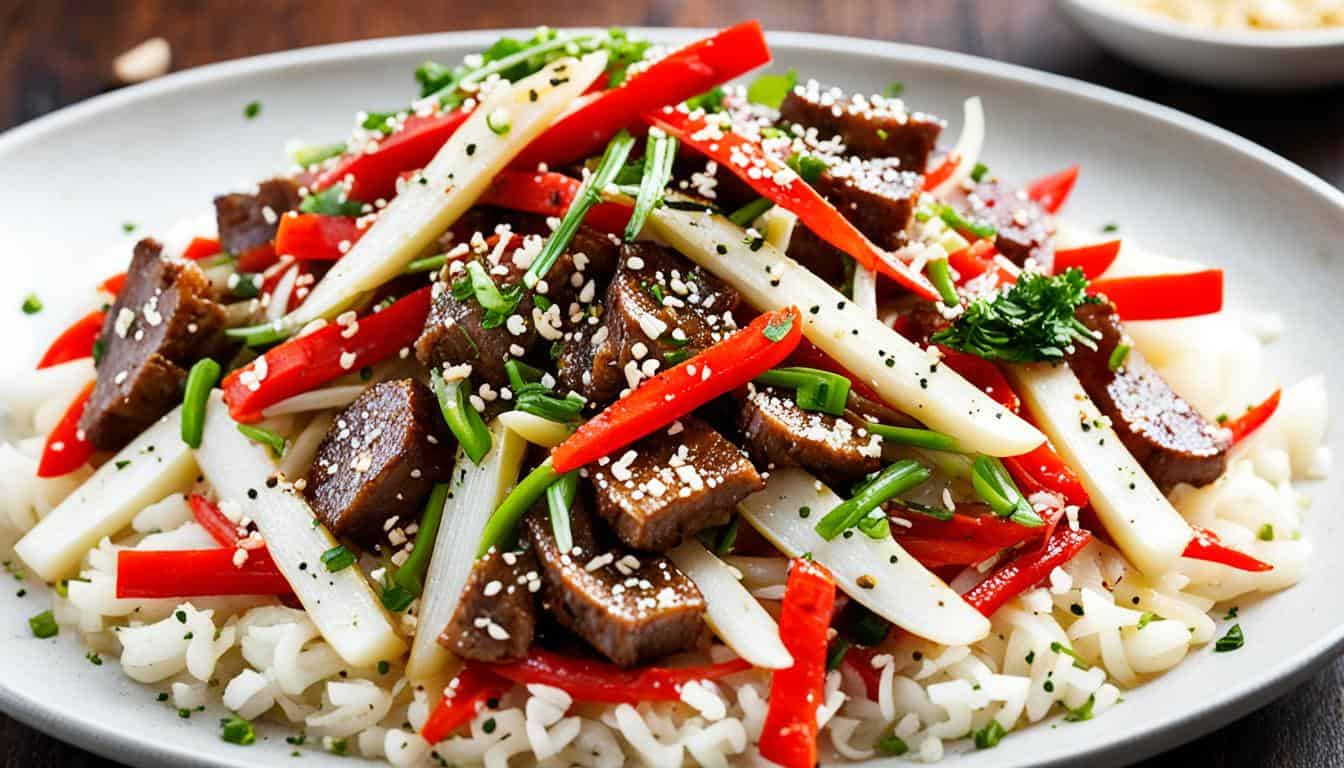
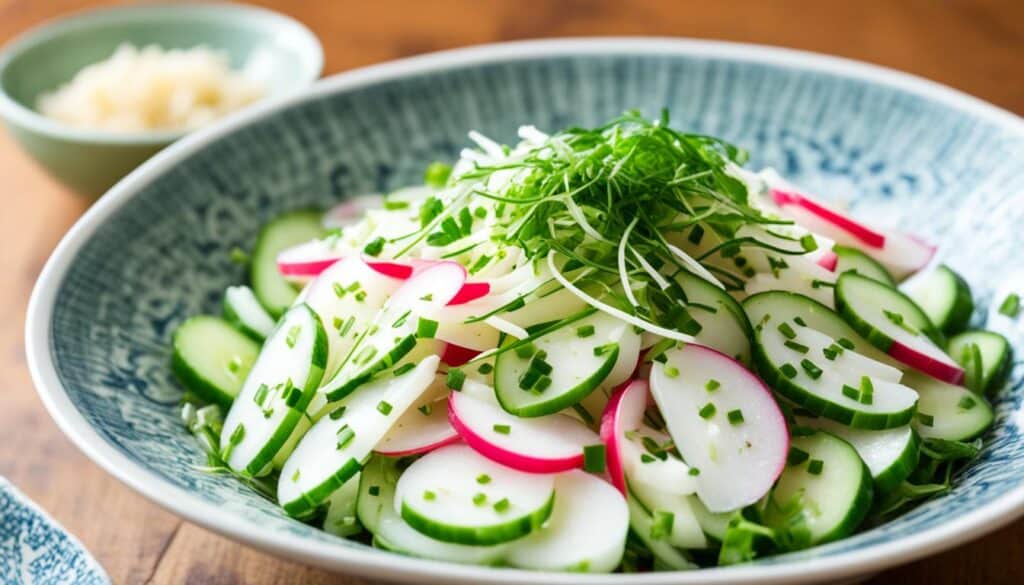
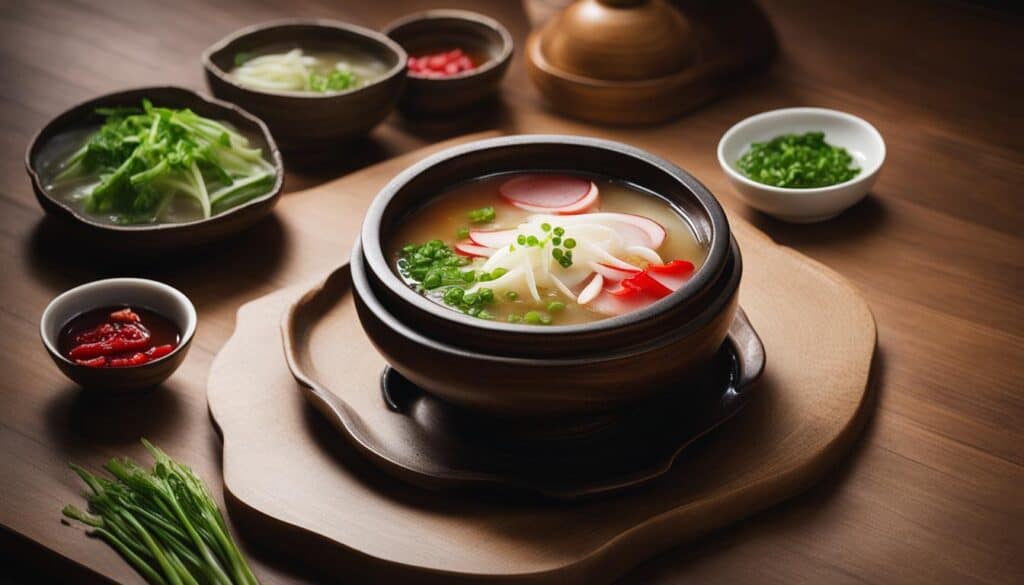
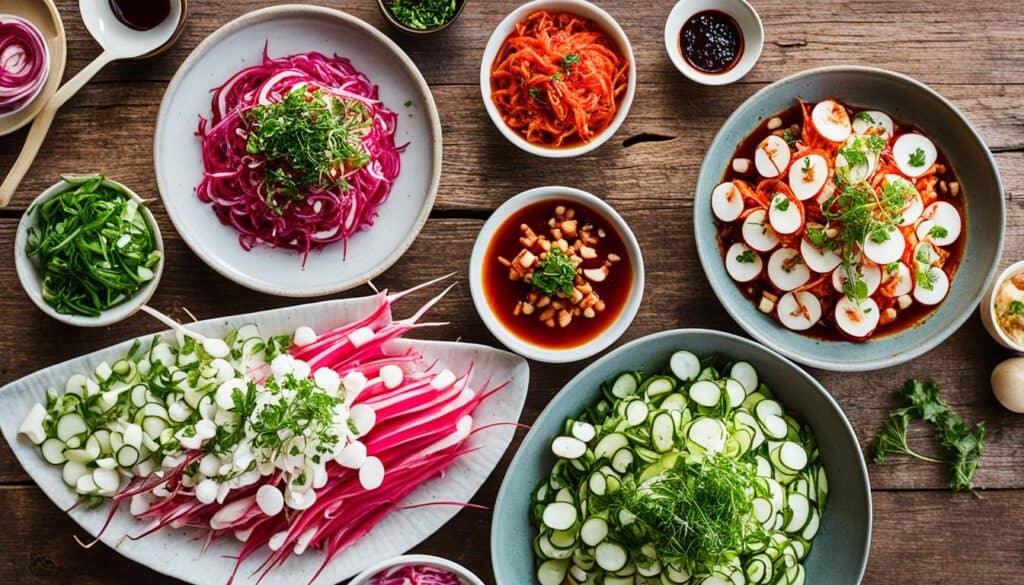
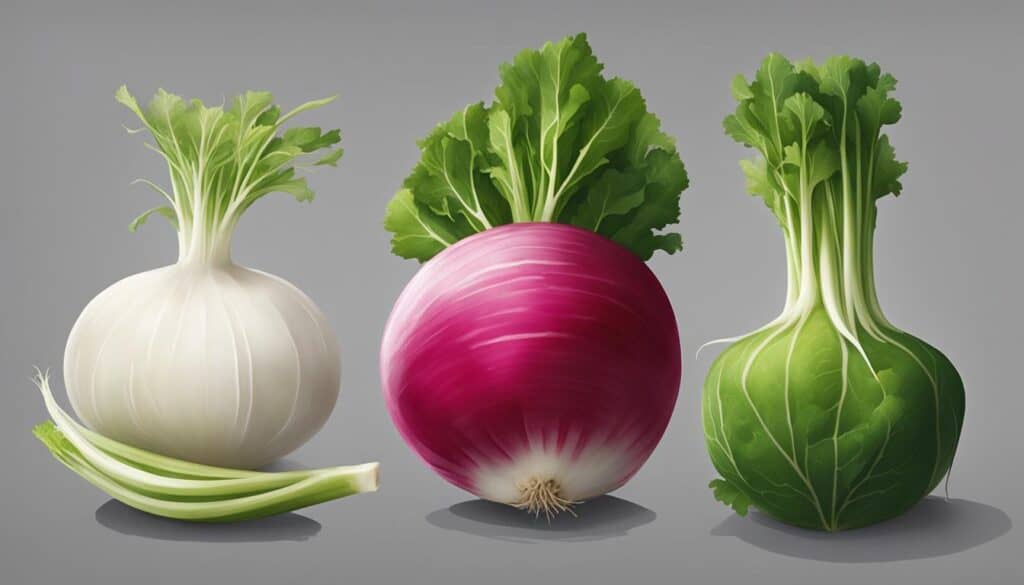
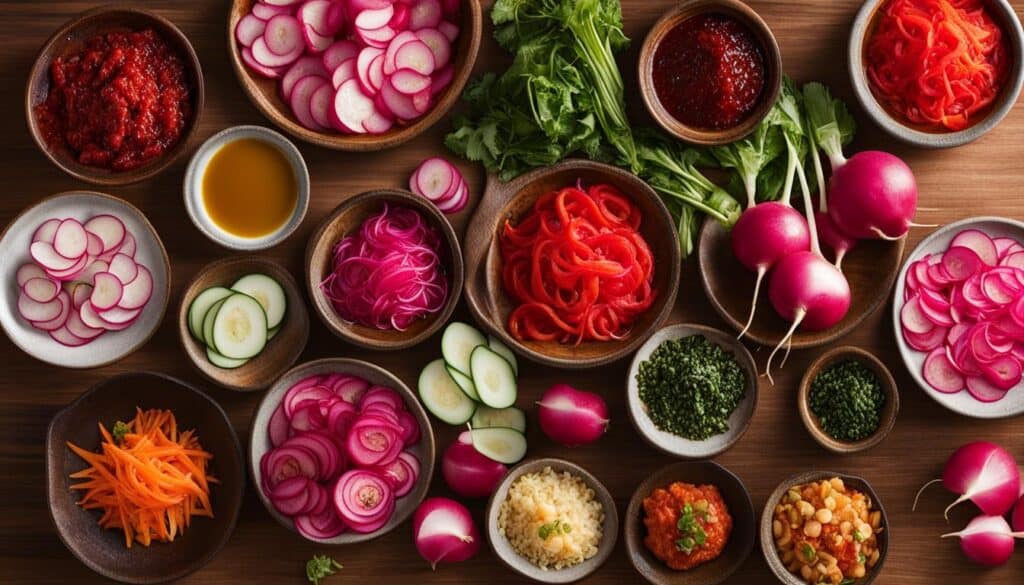



Leave a Reply